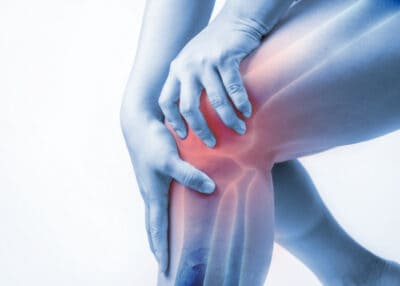Patellofemoral Pain Syndrome Specialist

Patellofemoral pain syndrome, also called “Runner’s Knee” can be caused by injury or inflammation of the quadriceps muscle, or quadriceps tendon attachments. This knee condition is caused when the nerves of the knee perceive pain within the soft tissues and bone surrounding the patella. If you are experiencing pain or tenderness in the knee, pain when sitting, or progressively worsening pain with activity, you may have patellofemoral pain syndrome. Doctor Matthew Provencher provides diagnosis and both surgical and nonsurgical treatment options for patients in Vail, Aspen, Colorado Springs, and the Denver, Colorado area who are experiencing symptoms of patellofemoral pain syndrome. Contact Dr. Provencher’s team today!
What is patellofemoral pain syndrome?
The knee joint, one of the larger and more complex joints in the body, is where the patella (kneecap) meets the femur (thigh bone) and tibia (shin bone). This sesamoid bone is attached to the femur, by the quadriceps tendon, and the tibia, by the patellar tendon. The undersurface of the patella is lined with articular cartilage, that allows the patella to painlessly glide up and down the trochlear groove with knee movement. Patellofemoral pain syndrome is a condition in which the nerves of the knee perceive pain within the soft tissues and bone surrounding the patella. This condition, also known as “Runner’s Knee”, is often caused by chronic use of the knee joint in intensive and repetitive physical activities such as running and squatting. Dr. Matthew T. Provencher, orthopedic knee specialist serving patients in Vail, Aspen, Colorado Springs, and the Denver, Colorado area, has the knowledge and understanding, as well as substantial experience in treating patients who have experienced patellofemoral pain syndrome.

What causes patellofemoral pain syndrome?
The knee joint, with its arrangement of bones, ligaments, tendons, and cartilage, can manage a significant amount of stress during daily and physical activities. Yet, with vigorous and chronic use of this joint, damage to these structures is inevitable. The following are some of the methods that can result in patellofemoral pain syndrome:
- Sudden changes in exercise routine. This can be a change in frequency, duration, or intensity of physical activities. This can also include changes in footwear or playing surface.
- Patellar malalignment. When the patella is pushed out of the trochlear groove on the femur, the patella and trochlea may experience more pressure causing irritation of the soft tissues. This abnormality can stem from malalignment of the legs, between the hips and ankles, or a high-riding patella (patella alta).
- Muscle weaknesses. The quadriceps muscle and quadriceps tendon are essential to knee movement. Any weaknesses or imbalances can lead to poor tracking of the patella within the trochlear groove.
What are the symptoms of patellofemoral pain syndrome?
A common complaint of patellofemoral pain syndrome is dull and diffuse knee pain that has gradually worsened. Pain when sitting with the knees bent for an extended period, or pain that worsens with physical activity, are other common complaints of patellofemoral pain syndrome. Some individuals have reported a “popping” or “crackling” sound with knee movement after sitting for a long period of time.
How is patellofemoral pain syndrome diagnosed?
A comprehensive medical history, including physical activity habits, will be obtained by Dr. Provencher. A thorough physical examination will also be performed to evaluate the knee joint. Although patellofemoral pain syndrome is typically diagnosed with a physical examination and medical history, diagnostic imaging, such as x-rays, Computer tomography (CT) and magnetic resonance imaging (MRI), are requested to identify damage to any other structures within the knee joint.
What is the treatment for patellofemoral pain syndrome?
Non-surgical treatment:
Most patients with a confirmed diagnosis of patellofemoral pain syndrome can alleviate symptoms with conservative therapies alone. A combination of RICE (rest, ice, compression, elevation) and non-steroidal anti-inflammatory medications (NSAIDs) are used to control the pain and inflammation associated with this condition. When appropriate, participation in a physical rehabilitation program aimed at strengthening the quadriceps muscle can improve knee range of motion. Taping the patella and custom-made shoe insoles can also be used to relieve knee pain.
Surgical treatment:
Surgical intervention for patellofemoral pain syndrome is rare and reserved for individuals with severe pain not previously relieved with conservative therapies. A minimally invasive surgical procedure involving a small camera (arthroscope) and specialized surgical instruments are used to examine and identify the cause of knee pain. One, or more, of the following surgical procedures may be implemented by Dr. Provencher:
- The damaged fragments of the soft tissues are excised and removed. Any other abnormalities, such as inflamed tissues, bone spurs, or loose bodies, are also removed with this procedure.
- Lateral Retinaculum Release. A common surgical treatment for patellar instability, the lateral retinaculum (fibrous tissue located on the outer patella) is released to help reposition the patella and alleviate tension on the outer knee.
- Tibial Tubercle Osteotomy. This open surgical procedure is employed when a shallow trochlear groove is the cause of patellar malalignment. The tibial tubercle (bony prominence of the shin bone), with the patellar tendon still attached, is transferred to another position on the tibia.
For more information on patellofemoral pain syndrome, or the excellent treatment options available, please contact the office of Dr. Matthew T. Provencher, MD, orthopedic knee specialist at The Steadman Clinic, serving Vail, Aspen, Colorado Springs, and the Denver, Colorado area.